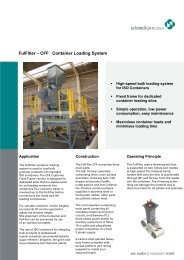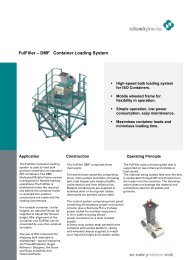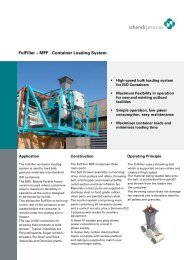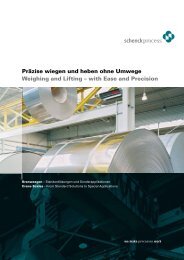Coal Feed Systems For Boiler and Coal Milling Plant - Redler Limited
Coal Feed Systems For Boiler and Coal Milling Plant - Redler Limited
Coal Feed Systems For Boiler and Coal Milling Plant - Redler Limited
Create successful ePaper yourself
Turn your PDF publications into a flip-book with our unique Google optimized e-Paper software.
<strong>Coal</strong> <strong>Feed</strong> <strong>Systems</strong><br />
<strong>For</strong> <strong>Boiler</strong> <strong>and</strong> <strong>Coal</strong> <strong>Milling</strong> <strong>Plant</strong><br />
Gravimetric <strong>and</strong> Volumetric <strong>Systems</strong> Belt <strong>and</strong> Chain Type <strong>Feed</strong>ers
� Stock Equipment Company established in 1929<br />
� First Gravimetric <strong>Coal</strong> <strong>Feed</strong>er (1957) designated as ASME Historic L<strong>and</strong>mark in 1995<br />
� More <strong>Feed</strong> System installations than all competitors combined<br />
8,000 <strong>Feed</strong>ers<br />
supplied worldwide<br />
� Proven reliability <strong>and</strong> long life in numerous applications<br />
� Technically superior design<br />
� Complete bunker to pulverizer system supply<br />
� Unparalleled customer aftermarket support<br />
� World wide manufacturing facilities<br />
� Factory trained <strong>and</strong> highly experienced field service personnel<br />
� ISO 9001 Quality Certification<br />
� Australia<br />
� Canada<br />
� Chile<br />
� China<br />
� Columbia<br />
� Costa Rica<br />
� Total service from parts supply to turnkey installations<br />
� Test Tower eliminates field R&D<br />
� Czech Republic<br />
� Dominican Republic<br />
� Guatemala<br />
� Hong Kong<br />
� India<br />
� Indonesia<br />
� Irel<strong>and</strong><br />
� Israel<br />
� Italy<br />
� Japan<br />
� Korea<br />
� Malaysia<br />
� Mexico<br />
� Morocco<br />
� Netherl<strong>and</strong>s<br />
� New Zeal<strong>and</strong><br />
� Pakistan<br />
� Philippines<br />
� Portugal<br />
� South Africa<br />
� Spain<br />
� Taiwan<br />
� Thail<strong>and</strong><br />
� Turkey<br />
� United Kingdom<br />
� United States<br />
� Ukraine<br />
� Venezuela<br />
� Vietnam<br />
� Zimbabwe
<strong>For</strong> close centred applications<br />
� The arrangement <strong>and</strong><br />
geometry of the<br />
bunker/feeder/mill has<br />
implications for the design of a<br />
Gravimetric <strong>Feed</strong>er, in both new<br />
<strong>and</strong> retrofit applications<br />
� A typical arrangement is<br />
shown, whereby the centre line<br />
of the feed to the mill is inside<br />
the line of the bunker outlet.<br />
� Also note that an emergency<br />
discharge facility is also<br />
required. (This tends to be an<br />
important feature, especially<br />
where volatile coals are being<br />
used <strong>and</strong> the residence time of<br />
the bunker is limited).<br />
� Composite Gravimetric <strong>Feed</strong>er:<br />
To h<strong>and</strong>le up to 70 tonnes/hr of coal.<br />
� Installed in a UK Power Station to replace an<br />
existing volumetric feeder<br />
The Composite Gravimetric <strong>Feed</strong>er<br />
EMERGENCY<br />
DISCHARGE<br />
FROM COAL BUNKER<br />
TO<br />
PULVERISER<br />
� The Gravimetric <strong>Feed</strong>er can be adapted to meet these dimensional constraints by applying the REDLER<br />
knowledge of conveying coal with a chain into a STOCK Gravimetric <strong>Feed</strong>er giving a most suitable <strong>and</strong><br />
practical design of feeder to deal with short centreline dimensions from inlet to outlet.<br />
� Custom designed to suit wide range of bunker sizes<br />
� Designed to close through a st<strong>and</strong>ing column of coal<br />
� Manual or Power operation<br />
� The Chain Conveyor in the lower part of the <strong>Feed</strong>er<br />
receives fuel from the Weigh Belt Unit <strong>and</strong> the<br />
discharge can be arranged at any point along the<br />
<strong>Feed</strong>er length. This arrangement suits applications<br />
for retrofitting that are being encountered<br />
Bunker Gates
Typical <strong>Feed</strong>er Arrangements<br />
The St<strong>and</strong>ard Gravimetric <strong>Coal</strong> <strong>Feed</strong>er<br />
� Designed to withst<strong>and</strong> 3.5 bar g explosion pressure per NFPA code 85<br />
� 2.1 m minimum centres inlet to outlet<br />
� 610 <strong>and</strong> 915mm inlet downspout sizes<br />
� Capacities over 100 tonnes/hr<br />
� Weighing Accuracy +/- 0.5%<br />
The Compact Gravimetric <strong>Coal</strong> <strong>Feed</strong>er<br />
� 3.5 bar g explosion pressure containment<br />
� 1.22m centres inlet to outlet<br />
� Weighing Accuracy +/- 1.0%<br />
� Capacities up to 100 tonnes / hour<br />
The Low Pressure Gravimetric <strong>Coal</strong> <strong>Feed</strong>er<br />
� Used on Fluid Bed <strong>Boiler</strong> <strong>Boiler</strong>s to deliver coal <strong>and</strong> limestone<br />
� Suitable for pressure up to 0.2 bar g<br />
Volumetric Belt <strong>Feed</strong>ers<br />
� All the major features of the Gravimetric<br />
<strong>Feed</strong>er, without the load cell weighing system<br />
� Minimum 610mm centres of inlet to outlet<br />
Volumetric Chain <strong>Feed</strong>ers<br />
� Designed to withst<strong>and</strong> 3.5 bar g<br />
explosion pressure per NFPA code 85<br />
� Fitted with <strong>Redler</strong> heavy duty chain<br />
� Capacities over 100 tonnes/hr
Because of the heterogeneity of coal, gravimetric<br />
feed systems have a number of advantages over<br />
volumetric systems when it comes to achieving<br />
optimized combustion in pulverized coal fired power<br />
plants, with lower emissions. Gravimetric systems<br />
are widely used in the USA, volumetric feeders<br />
currently predominate in Europe, but with the<br />
growing pressure to reduce emissions this is likely to<br />
change.<br />
� The gravimetric feeder weighs material on a length of<br />
belt between two fixed rollers using a weighing<br />
roller.<br />
� Belt speed is determined by a tachometer attached<br />
to the motor shaft. A microprocessor multiplies the<br />
speed <strong>and</strong> weight signal to arrive at the feeder<br />
output.<br />
� The microprocessor matches the feeder output to the<br />
dem<strong>and</strong>ed output by adjusting the feeder motor<br />
speed.<br />
Why Gravimetric <strong>Feed</strong>ing of <strong>Coal</strong>?<br />
Maintaining the correct amount of<br />
coal to the pulverizer is not a simple<br />
task since the coal properties<br />
constantly vary due to sizing<br />
differences <strong>and</strong> the adverse impact<br />
of moisture on heating value, flow<br />
characteristics, <strong>and</strong> density.<br />
The effects of moisture on coal has<br />
been studied for many years with<br />
research conducted by many<br />
The differences in the amount<br />
of coal delivered to the<br />
pulverizer <strong>and</strong> hence the<br />
burners by a volumetric <strong>and</strong><br />
gravimetric feeder are<br />
illustrated on this chart.<br />
Due to the difficulties in burning<br />
coal, it is necessary for excess<br />
combustion air to be added to the<br />
furnace in order to ensure safe <strong>and</strong><br />
complete burning of the fuel. This<br />
excess air is typically 15% to 18%<br />
depending upon the volatile<br />
content of the fuel.<br />
When firing coal, there is currently no effective way<br />
to measure kilojoule (BTU) flow, so this value must<br />
be inferred from either volume or weight flow. The<br />
volume flow measurement will be in error by the<br />
variation in both density <strong>and</strong> heating value, whereas<br />
the weight flow signal will be in error only to the<br />
extent of the variation in heating value. The<br />
gravimetric feeder is vital if an accurate flow rate is<br />
to be maintained irrespective of density changes.<br />
institutes, who have published data<br />
illustrating how coal density<br />
decreases with increasing moisture<br />
levels within the ranges typically<br />
experienced at coal fired power<br />
plants. The effects of moisture is<br />
also dependent upon the particle<br />
sizing of coal which generally<br />
reflects a lower density level for<br />
smaller sizes.<br />
Summary of Benefits<br />
� Fuel Savings through Improved <strong>Boiler</strong> Efficiency<br />
� Improved Combustion Efficiency/LOI<br />
� Improved Pressure <strong>and</strong> Superheat Control<br />
� Less Slagging <strong>and</strong> Pluggage<br />
� Less NOx through Better Control of Excess Air<br />
� Less Corrosion<br />
� Stability <strong>and</strong> Improved Response of<br />
Combustion Controls<br />
� Reduced O&M costs<br />
� Improved <strong>Coal</strong> Mill Performance<br />
� Safety<br />
Variations in the amount of fuel<br />
delivered to the burners due to<br />
density changes <strong>and</strong> the feeders<br />
accuracy also requires additional<br />
air to avoid loss of carbon <strong>and</strong><br />
unsafe conditions within the<br />
furnace. This additional air goes up<br />
the stack <strong>and</strong> represents an<br />
efficiency loss for the plant.<br />
Gravimetric <strong>Feed</strong>er Principle
Accuracy<br />
Accurate fuel delivery ensures stable combustion<br />
control <strong>and</strong> rapid response to changes in boiler<br />
load. The STOCK ® gravimetric feeder is designed<br />
to provide uninterrupted fuel delivery with a feed<br />
rate accuracy of +/-0.5%. Proven accuracy <strong>and</strong><br />
reliability have been demonstrated over decades<br />
of practical experience.<br />
Dual Load Cell Weighing System<br />
Dual load cells combine maximum accuracy with<br />
reliability. The outputs are checked against each<br />
other prior to transmission to the feed rate<br />
circuitry.<br />
Excessive deviation or an unreasonable signal<br />
results in immediate <strong>and</strong> automatic transfer to a<br />
volumetric feed mode without interruption of flow<br />
ACCUFLEX ® <strong>Feed</strong>er Belt<br />
ACCUFLEX is a mechanically spliced, single-ply<br />
feeder belt that enhances long-term feeder accuracy,<br />
has the strength of a two-ply belt, <strong>and</strong> is easily<br />
installed. A molded V-guide maintains proper<br />
tracking. Molded, notched belt curbs minimize dust<br />
spillage.<br />
Weighted Belt Scraper<br />
Typical Stock <strong>Feed</strong>er<br />
The scraper effectively cleans the outside of the<br />
belt.<br />
Alarms<br />
Alarms are located downstream from the feeder<br />
inlet, <strong>and</strong> at the feeder discharge, to indicate the<br />
presence of coal on the feeder belt <strong>and</strong> to detect coal<br />
pluggage to the mill.<br />
<strong>Feed</strong>er Construction <strong>and</strong> Features<br />
<strong>Feed</strong>er Inlet<br />
The feeder inlet is constructed of solid, type 304,<br />
stainless steel. A replaceable stainless steel<br />
levelling bar shears the coal column, forming a<br />
uniform profile of coal on the belt necessary for<br />
accurate weighing.<br />
Head Pulley<br />
The pulley is machined flat to within 0.13mm T.I.R.<br />
A multiple pin <strong>and</strong> bushing coupling simplifies<br />
pulley removal.<br />
Take –Up Pulley<br />
The pulley body is slotted <strong>and</strong> contains an internal<br />
helix to provide self-cleaning operation. The pulley<br />
face is also crowned to facilitate belt tracking.<br />
Belt Tension/Take –Up<br />
Belt tracking <strong>and</strong> tensioning are accomplished by<br />
means of a unique take-up assembly consisting of<br />
two externally operated stainless steel,<br />
spring–loaded screws. The take-up screws have<br />
hex heads to accommodate a ratchet wrench.<br />
Cleanout Conveyer<br />
Malleable iron drag chain continuously clean any<br />
dust accumulation from bottom of the feeder.<br />
Internal Illumination (Optional)<br />
Work lights located at each end of the feeder<br />
provide excellent illumination of the feeder interior.<br />
Light bulbs can easily be changed from outside the<br />
feeder body without disrupting the pressure<br />
integrity of the feeder shell.
Body shell<br />
The 8mm thick carbon steel construction<br />
exceeds NFPA Code 85 <strong>Boiler</strong> Code<br />
requirements of 50 psi (3.5 bar g) explosion<br />
pressure containment. All parts that contact<br />
the active coal flow are fabricated of type 304<br />
stainless steel or rubber.<br />
Access Doors<br />
Large access doors are designed for easy<br />
entry <strong>and</strong> convenient feeder maintenance.<br />
Each end door is secured with heavy duty<br />
fasteners for rapid entry. Two glass ports are<br />
located in each end door for viewing belt<br />
tracking <strong>and</strong> coal flow.<br />
Two-line vacuum fluorescent<br />
display with forty alphanumeric<br />
characters per line<br />
LED indicators on MODE keys<br />
Functional grouping of keyboard<br />
into five areas-Calibration, Mode,<br />
Programming, Operation, <strong>and</strong><br />
Status<br />
Features:<br />
� An alphanumeric display that clearly communicates text messages to the operator, reducing the use<br />
of the operating manuals<br />
� Highly integrated electronics which result in fewer components <strong>and</strong> improved reliability<br />
� Hourly calibration of load cell circuitry is performed automatically <strong>and</strong> eliminates system drifts due to<br />
time<strong>and</strong> temperature<br />
� Keyboard designed for simplified operator interface allows direct entry <strong>and</strong> recall of site-specific<br />
parameters<br />
� All operating information <strong>and</strong> program data stored in non-volatile memory without requiring battery<br />
backup<br />
� Built-in diagnostics to assist in system troubleshooting<br />
� Shell Being Machined<br />
The <strong>Feed</strong>er Controller<br />
� The STOCK 196NT microprocessor system is a refinement<br />
of proven electronic controls designed to operate in power<br />
plant environments where harsh conditions <strong>and</strong> frequent<br />
power disturbance exists.<br />
� Special circuits, software subroutines <strong>and</strong> nonvolatile<br />
memories for process data are utilised for maximum system<br />
availability <strong>and</strong> performance.<br />
� The controls are housed in enclosures rated NEMA 4 or<br />
better.<br />
Numbers displayed with a label<br />
(Rated) <strong>and</strong> selectable<br />
engineering units (Lbs/hr)<br />
Environmentally sealed membrane<br />
switch keyboard<br />
Thirty-one embossed function keys<br />
with tactile feedback<br />
LED indicators for system STATUS<br />
� Designed for long-term accuracy without frequent calibration. Calibration is performed by the<br />
microprocessor <strong>and</strong> the procedure is fast, accurate, <strong>and</strong> automatic.
Stock <strong>Redler</strong> <strong>Limited</strong><br />
<strong>Redler</strong> House<br />
Dudbridge, Stroud<br />
Gloucestershire<br />
GL5 3EY Engl<strong>and</strong><br />
T +44 (0) 1453 763 611<br />
F +44 (0) 1453 763 582<br />
sales@redler.com<br />
Publication No. 29/06<br />
Schenck Process GmbH<br />
Pallaswiesenstraße 100<br />
64293 Darmstadt<br />
Germany<br />
T +49 61 51-32 10 28<br />
F +49 61 51-32 11 72<br />
sales@schenckprocess.com






